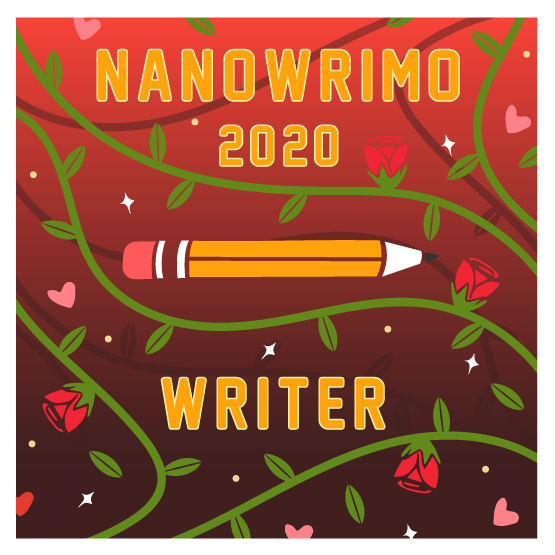Preparing for NaNoWriMo (National Novel Writing Month) means starting now. NaNoWriMo happens every November, but the weeks leading up to it are the time to plan and prepare. This annual event is an opportunity for writers to make significant progress on a novel or writing project.
NaNoWriMo
In simplest terms, NaNoWriMo is a 30 day challenge to write 50,000 words. If you do the math on that, it amounts to 1,667 words per day, everyday for the entire month of November. Miss a day and that number goes up. It’s doable, but it takes commitment. (For comparison, this post is just under 1,000 words.)
Participants register on the NaNoWriMo site and can use the site to track their progress with word count. The site includes various resources to help writers. There’s a community of writers to support participants. Some people arrange to gather at a writing spot to encourage each other to keep writing. There’s no cost to participate, although a donation is appreciated. The recognition for reaching 50,000 words includes bragging rights and a printable certificate. Finally, completing 50,000 words is a sizable part of most novels.
My Previous Participation
I’ve entered NaNoWriMo three times years ago, although one doesn’t really count because I signed up and then didn’t follow through. The two times that I made a genuine effort to participate, I never reached 50,000 words. I think I completed around 20,000 on my first serious attempt. When I made more effort, I finished 30,000 words. Both times I sat down and started writing without a plan of where I was going. It’s called being a pantser (writing by the seat of your pants).
Preparing for NaNoWriMo 2020
This year I’m taking a different approach. I’m preparing for this event as if it’s a marathon. I’m studying the route, creating a conditioning plan, and exercising my writing muscles. Nice comparison, but what does that look like for writers?
Studying the route – I read a book called Write-a-thon by Rochelle Melander. It’s subtitled: Write your book in 26 days (and live to tell about it). This is even more intense that NaNoWriMo, since it’s four less days and the entire book. Key points from the book are summarized below.
Creating a conditioning plan – This is my version of defining characters, establishing character backstories, establishing conflicts, and outlining the plot.
Exercising my writing muscles – Writing becomes a habit when it is practiced consistently. My prep work includes writing on a predictable schedule building up my word count each day.
With these steps, I anticipate a more productive NaNoWriMo in 2020.
Write-a-thon Highlights
One of the first recommendations of the Write-a-thon book is to eliminate excuses. Identify the excuses you typically use for why you don’t write (time, talent, experience, age, space, ideas, etc…). Then be honest and determine what you can do to get rid of that excuse. Most excuses are not true. You might need to change some current activities, but it can be done if you are serious about writing.
Envision your desired state. Picture yourself reaching your desired goal. Many athletes use this technique. Once your brain is convinced you are serious about writing every day, you will find yourself craving your writing time.
Share your goals with others. Encouragement from others is a strong motivator. One of the reasons I’m writing this blog is to share my NaNoWriMo plans with you, my readers. I don’t want to let you down, by not writing anything in November, after taking all this time to discuss preparations.
Pre-writing is a great warm-up exercise. Try creating a mind map to capture your ideas. Put your central idea or possible title in the center of the page. Then around that start jotting down bits of your story idea, characters, potential scenes, and conflicts. Don’t worry about putting them in any particular order. Fill the page without editing or worrying about grammar and spelling. Connections may begin to materialize. Another option for pre-writing is to create character backstories by writing about your character’s childhood or events prior to the onset of your story.
Planning your novel includes understanding your genre, selecting a point of view, outlining your plot, identify rewards for accomplishment of mini-goals during the writing period.
Write anyway! Even when you don’t feel like, write. Maintain the habit of writing daily or at whatever frequency you have selected.
Preparing for My NaNoWriMo
I’ve started preparing for NaNoWriMo because it will be here before I know it. Here’s what I’ve done already:
- Identified my excuses for not writing. My biggest excuse is not enough time. I know that sounds silly for a retired individual to say, but I’ve managed to fill most my day with activities. Writing has moved higher on my daily activity list.
- Set up a reward system. I’m using a daily calendar. Each day that I write, I add a sparkly star to that day. I know, it sounds juvenile, but it’s amazing what the sight of those shiny stars does for my motivation. This technique has worked for exercising and art, so I expect it to work for writing too.
- Shared my goals. This post is one of several steps I’m taking to share my intentions for November. I’ve shared my desire to do NaNoWriMo this year with one of my on-line writing groups too.
- Started pre-writing. I began with a mind map. Then I graduated to larger sheets of paper, one for each character and sketched out their major scenes. I wrote a short scene with two of my characters to get a feel for their dialogue and mannerisms.
- Researched several topics that will be included in my novel. YouTube videos have been helpful.
- Next up is creating a plot outline. More to come.
Let me know if you are interested in hearing more about my activities while I’m preparing for NaNoWriMo 2020.
